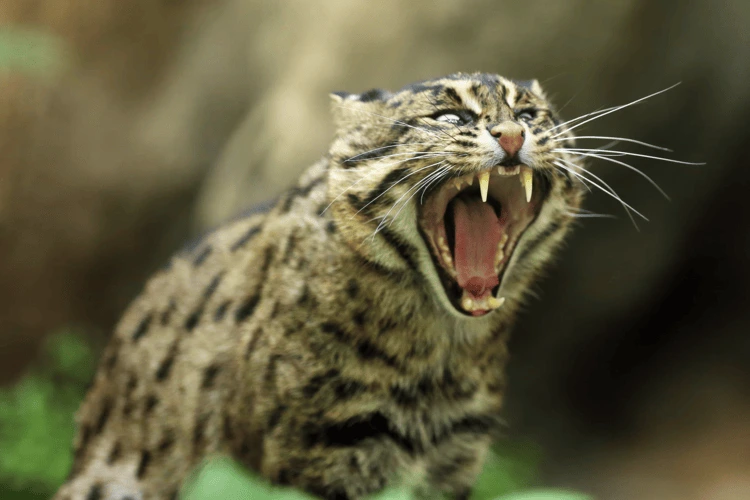
Simon Payne goes in search of an elusive wild cat – the fishing cat – that’s the size of a spaniel, quacks like a duck & looks like a leopard
By Simon Payne
Thalangama tank is a lush green lake built to bathe Sri Lankan army elephants in the 15th century. Today, it has been absorbed by Colombo’s sprawling suburbs, surrounded by comfortable villas and constant traffic noise. I had spent a hot afternoon looking for signs of Colombo’s fishing cats, and a sugary bun from the bread van was a welcome treat. Hardly anyone in this affluent residential area had even heard of these enigmatic wild predators, which have relatively recently taken to city life.
However, Sumith, the bread seller, was the exception and grinned as he boasted that he had caught glimpses of one a couple of times very early in the morning. ‘I feel glad I saw one,’ he said. ‘I am very lucky.’
Interested in wildlife stories? Why not check our other articles out…
I had not been so lucky, and I felt I was searching for what seemed to be Colombo’s version of TS Eliot’s hardly ever seen Hidden Paw. The fishing cat (Prionailuruas viverrines) is listed as vulnerable on the International Union for the Conservation of Nature’s Red List and is found in the rural swamps and marshes of South and Southeast Asia. It’s nocturnal and is one of the few cats that are strong swimmers, even underwater. Only in Sri Lanka’s capital has it become a city cat.
Colombo lies on the low-lying coastal plain in the Kelani River basin. It’s the only capital city in the world to have City status under the Ramsar Wetlands Convention. It was granted in 2018 in recognition of the extraordinary wetlands that make up nearly 20 per cent of greater Colombo’s 120 square kilometres. The wetlands include the Kelani River and tributaries, many man-made lakes or ‘tanks’, as they’re known, dating back to as early as 300 BCE, paddy fields and a canal network stretching for more than 100 kilometres developed by the Dutch during their colonial rule between 1658 and 1796. The city wetlands are a biodiversity hotspot, home to the fishing cat and some 277 other species of animal and 285 species of plant. However, with 2.4 million people living in the city, there is intense pressure on the Metro Colombo Wetland complex.
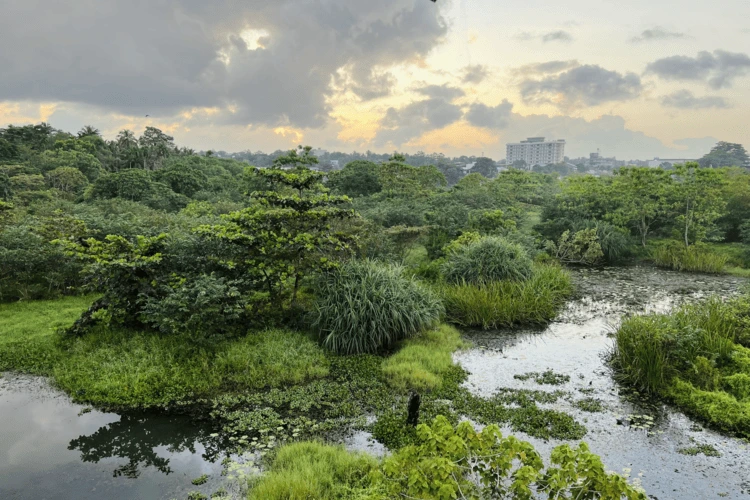
In 2010, devastating floods submerged much of Colombo, displacing some 300,000 people and causing US$100 million of damage. Further major flooding incidents occurred in 2016, 2017 and early this year.
Since the turn of the century, floods across Sri Lanka have killed hundreds and displaced an estimated 1.5 million people. Chethika Gunasiri, a wetland specialist from the University of Tokyo and environmental scientist at the Sri Lanka Land Development Corporation, told me: ‘Weather patterns have changed dramatically. So in the last 20 years, flood occurrence and flash floods have rapidly increased.’
One estimate is that the frequency of major floods may already have more than doubled.
The presence of fishing cats in the urban heartland of Colombo was little noticed or understood until 2015. The founder of the Urban Fishing Cat Conservation Project (UFCCPA), biologist Anya Ratnayake, told me the story of the prize US$100 dragon koi carp that kept being stolen from a garden pond in Havelock in the heart of the city. Security camera footage eventually revealed the culprit was a fishing cat, which was subsequently found trapped in a storm drain. ‘He was the first city fishing cat to be collared,’ Ratnayake said. ‘This revealed that he was living entirely in the heart of the capital – and more camera footage and sightings showed he was not alone.’
Fishing cats aren’t the only wild cats that have adopted city life. Around 50 leopards live in and around the Mumbai megalopolis – concentrated on city green
space Aarey Forest and Sanjay Gupta National Park.
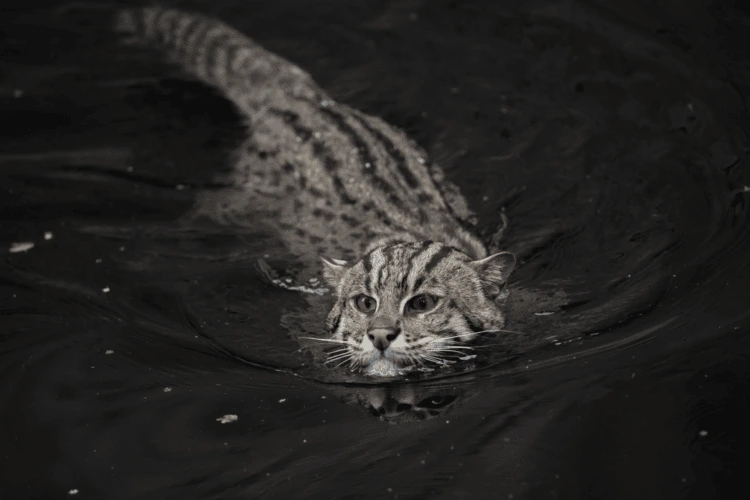
Los Angeles has more than 100 mountain lions living in the Santa Monica hills, rubbing shoulders with Hollywood stars and making forays into the city. Deaths on highways have led to the construction of the world’s largest wildlife crossing over Highway 101, which is due to open in 2026. And in Cape Town, caracals have adapted to life among its five million residents.
Ratnayake pointed out that this isn’t so surprising: ‘Cats are very adaptable – what biologists describe as “behavioural plasticity”. We see it most strikingly in the diet of fishing cats in Colombo. The ones living in the city eat mainly rodents, then birds, reptiles and finally fish. Studies in more natural, non-urban environments reverse that order, with fishing cats living up to their name.’
One of UFCCP’s earliest findings was that fishing cats in Colombo are ‘hyper-urban’. ‘Remarkably, Colombo’s fishing cats are resident within the heart of the city, where population densities are much higher than comparable, often suburban, areas in Los Angeles or Mumbai,’ Ratnayake observed. ‘What I am trying to figure out is why? Is it something about the cat or Colombo?’
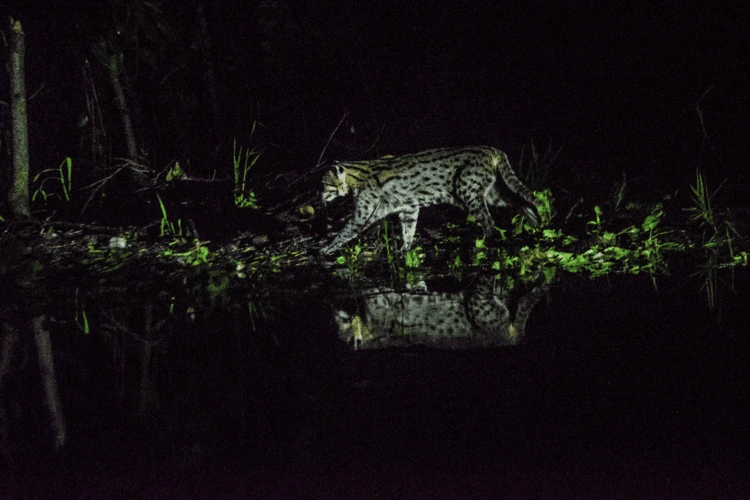
Key factors for the feline invasion are Colombo’s legacy of colonial houses and gardens, which provide a web of ‘little green islands’, and the Dutch canal system – a network of wildlife corridors for the cats to roam and, of course, the wetlands. Ratnayake explained: ‘We have an extensive wetland complex that spreads right into the city and when we look at camera traps and GPS collars, it is the key habitat’.
Just across the highway from the Sri Lankan parliament is Diyasaru Park, 25 hectares of lakes well connected to other wetlands and known to be home to at least nine fishing cats. In the tropical stickiness of the monsoon, Anjallee Prabhakaran, a wildlife biologist with UFCCP, took me on a tour. She described the fishing cat as about the size of a medium-sized dog, leopard-like, with grey and darker stripes and spots. She explained that they’re highly adapted, stocky, with a seal-like head streamlined and elongated for diving, broad jaws for grasping slippery prey, webbed paws for swimming, a short tail and semi-retractable claws on the back paws to help them keep a secure hold on the bank when fishing.
Biologists consider them EDGE species – evolutionarily distinct and globally endangered. Prabhakaran added: ‘They are good swimmers. Sometimes, they have been observed dabbing the water’s surface with a paw to imitate a struggling insect and attract fish. And their call, believe it or not, is like a duck quacking.’
They are also extremely elusive. In ten years of working on the fishing cat project, Prabhakaran has only had two momentary sightings. One in Diyasaru and one of a cat crossing the road. Without camera traps, GPS collaring and scat analysis by the team at UFCCP, we would know almost nothing about the mystery cat.

Globally, fishing cats are threatened by conflict with humans, often over cats taking chickens or goats. There are reports of cats being shot and beaten. But in Colombo, conflict with humans is rare – in fact most people don’t even know that they’re around. The big threats are from vehicle collisions and habitat loss and degradation, especially the wetlands.
Wetlands are threatened by multiple drivers. Dr Gunasiri broke down the key factors: ‘The 2010 floods were a catalyst for a change of political attitude towards development and infilling of wetlands but even now wetlands are lost each year. The total area is decreasing by around 25 hectares annually’. She adds that the human population is increasing with particular pressures on suburban zones – areas rich in tanks and paddy fields. ‘One of the main threats for the urban wetlands is from invasive plant species such as pond apple (Annona glabra) and water hyacinth (Eichhornia crassipes) choking the wetlands of oxygen and making them more terrestrial by collecting soil and reducing water holding capacity’.
UFCCP uses its network of volunteers to help beat back these alien plants and keep the wetlands wet.
Garbage and littering in the city are also major problems, particularly with regard to plastics. Canals and lakesides are often clogged with discarded plastic waste. Ratnayake’s paper in the journal Environmental Pollution revealed that plastics are becoming established in Colombo’s wetland food webs, and unsurprisingly, as the cats are apex predators, they are ingesting micro, meso and macro plastics.
Back at Thalangama Lake, I met up with Pay Drechsel, a German environmental scientist living in Colombo, on his evening litter collection. He leads the community-based Thalangama Wetland Watch, tackling litter and trash in the streets and the lake. He said: ‘There is a certain level of education and environmental awareness that does not exist in the majority of the population, which when combined with under-resourcing and a lack of capacity among the authorities has led to the huge level of trash in the environment’.
The area around this historic tank is litter-free, and the group also reduces invasive water hyacinths. This volunteer group has removed more than 1,000 cubic metres of waste, mainly plastic, from one lake alone over five years. When asked about fishing cats, he said that despite his twice-daily litter collection dog walks, he has only seen the Hidden Paw once – fleetingly crossing a nearby paddy field late at night.
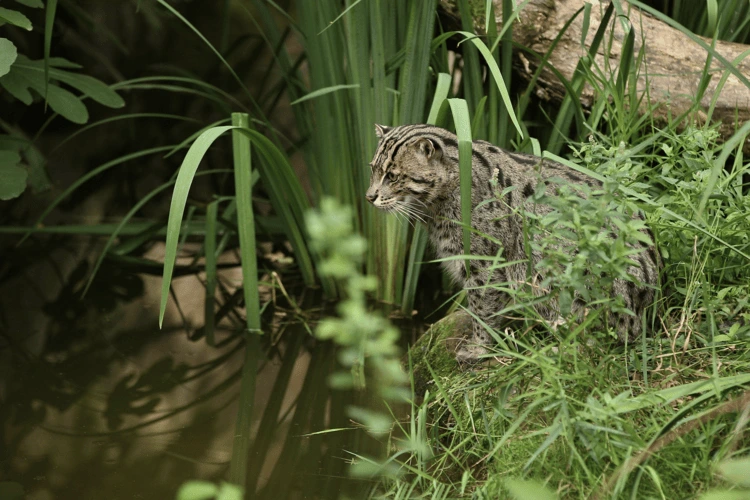
Water pollution is also a threat. Gunasiri explained that the mass of new development, especially high-rise, often lacks adequate wastewater treatment, resulting in raw-sewage pollution in rivers, canals and lakes. She suggested that ‘something like a betterment tax paid by developers’ to pay for infrastructure and wetland protection would help hard-pressed authorities.
She said: ‘During monsoon, when it rained, there was a thick, oily scum in the water flowing into the wetlands, and we found there was a big drop in fishing cat activity’.
Wetlands in lowland areas provide crucial ecosystem services. For Colombo, the 20 per cent of the city that is wetland acts as a sponge for flood management, lungs to improve air quality, kidneys naturally filtering out many pollutants, and air conditioning units cooling tropical heat. Besides all this, the wetlands are important areas for tourism and recreation, often combining jogging tracks, picnic areas and nature trails.
Gunasiri explained that these nature-based solutions to some of Colombo’s problems, such as flood risk, poor air quality, polluted water and overheating, were recently evaluated by the World Bank as providing environmental services valued at US$60 million yearly. Wetland loss threatens biodiversity, the city’s environment and, of course, the fishing cats.
‘Without that cat, I don’t think we would be able to properly protect our wetlands,’ she argued. ‘If I told people we have saltwater crocs in our wetlands and we need to protect them, they are going to say, “Hell No!” Or there are buffalo leeches in our wetlands, we need to protect them. They’d say, “Burn it with fire.” But when I tell people we’ve got this cat that looks like a leopard, it’s the size of a spaniel, quacks like a duck, and swims like a fish, people respond, “That’s so weird. That’s so funny. That’s so interesting. I wanna go see that cat’’.’
After some 500 events, from school talks and wetland walks to government briefings, Ratnayake’s dream of Colombo’s fishing cats becoming a flagship species is slowly coming true. ‘When the government wanted to build a highway extension through Thalangama, residents objected, arguing that there are unique animals and plants in these wetlands,’ she said. The road eventually took a different route.
She added: ‘Wetlands and fishing cats are so intricately interconnected. They’re both kind of pulling their weight in conservation equally. Without the wetlands, Colombo won’t survive; after all, it was built on a wetland.’




